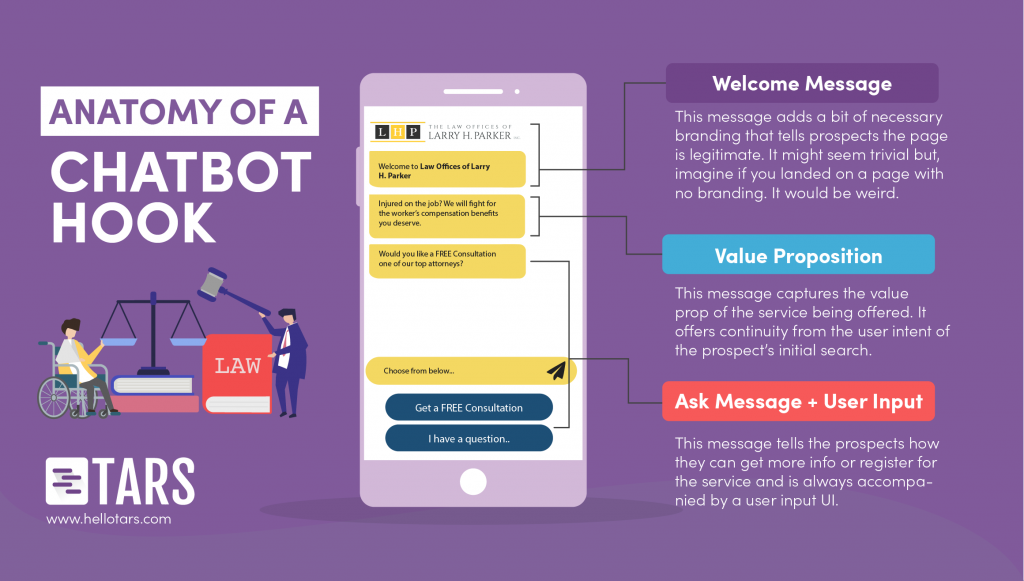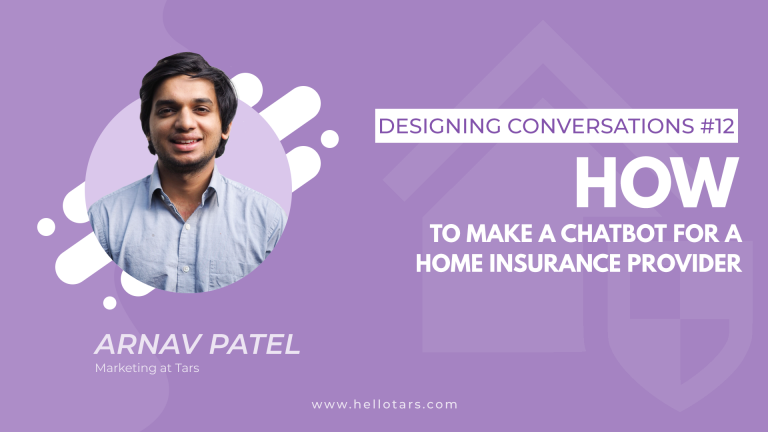[Designing Conversations] How to Make a Conversational Landing Page for a Workers’ Compensation Law Firm

The average legal client doesn’t have legal expertise and cannot tell a good lawyer from a bad lawyer. Add the insanely high Google Ads cost per click on legal keywords and you have to deal with a perfect storm of high-cost traffic yielding abysmally low conversion rates.
An effective strategy to negotiate this treacherous marketing landscape is to optimize your landing page. Conversational Landing Pages reimagine the way landing pages ought to look and feel by organizing the information as a conversation. This gives the uncertain legal client a guided buyer experience that converts at rates that are 2-3x higher than a traditional landing page.
Of course, to see this benefit, you need to learn the art of conversational design. This guide is the ultimate cheat sheet to learn all of the ins and outs of conversational design for legal marketing within a matter of minutes. Follow the best practices and methods below and you will definitely see an increase in conversion rate that will make you question how you ever settled for the sub-par results of your traditional landing page.
Check the Larry H Parker conversational landing page: http://bit.ly/2W372G3
And the Larry H Parker traditional landing page: http://bit.ly/2KX7uEO
Landing Page Assessment
As always I found the landing page that I transformed through a Google Ad. I looked up Workers Compensation Lawyer, clicked on one of the ads and found this landing page from the Law Offices of Larry H Parker:
The most striking aspect of this page is how many CTAs the page has on it: over 10 in the first fold alone. Combine this with the text-heavy nature of the page and the landing page is far from ideal, especially in the legal marketing space. Regular prospects have low attention spans and do not read much text. Legal marketing prospects are even worse on this front. They are usually dealing with the stress of their case and this makes them more discerning with their attention, meaning that an overload of CTAs will surely cause them to drop.
Conversational Landing Page Creation
While building your conversational landing page, the main rule that you should always keep in mind is “keep the experience as human as possible.” Your conversational landing page is a representative of your law firm and it needs to behave that way. This means providing customer service at the level you would expect from a human representative. In real terms, this means incorporating a set of best practices to make your messaging feel as human as possible. Here is a cheatsheet for the most important ones that you should never forget.
The Hook
As always, the first stage of conversational landing page design is phrasing the hook. The hook is the most important part of the whole conversation. It is a series of three messages that your prospect sees when they first land on your page. It is in these messages that you must build legitimacy, capture your prospects attention and get them to start the conversation. Failing to do so will make them drop and waste your adspend.

While contemplating your hook there are four best practices you should always keep in mind:
- Use a logo in the welcome message- The welcome message builds legitimacy and nothing builds legitimacy better than a logo. We take it for granted that a landing page will have a logo on it, but when it’s missing the page feels super generic to the point where some prospects might drop when their spam alarm bells go off. Add a logo in the first message to avoid this unfortunate outcome.
- Keep your value proposition short- Nothing longer than a tweet. Your value proposition message serves the purpose of capturing user attention by telling them that you offer what they are looking for. But, if you phrase it as an essay, no one will read it and you certainly won’t capture anyone’s attention.
- Make your ask uncontroversial- Through experimentation, I’ve found that prospects don’t like sharing personal information as soon as they land on your page. This is why we recommend that you ask your prospects an uncontroversial question which at the start. A good uncontroversial question is one which doesn’t expect any real information from the prospect at all. For example, if you ask your prospects to click a “Get a FREE Case Review Button,” you aren’t asking them to share anything personal and they can close out if they don’t like what they see next. But, by making it easier for them to click, you have gotten them invested in the interaction and reduced the likelihood of them dropping.
- Use a button as user input- This best practice really boils down to simple math. It takes fewer taps to press a button than it does to type out a word. Buttons reduce the friction to continue a conversation and as a result reduce the number of people dropping from your page right at the start.
Lead Generation Experience
Collecting a lead through a conversation is completely different from collecting it through a form. Forms are impersonal and as a result, prospects don’t expect much from them. You can have a set of blank fields with single-word labels and that is socially acceptable. If you are capturing a lead through chat however, you are bound by the rules of basic human etiquette and good customer service. In practice this means following at least the following best practices:
Ask full questions
This goes without saying, but if you had a human customer service rep who said “name?” to a customer over live chat, you’d probably fire them. Treat your conversational landing page the same. Ask for details through full questions
Acknowledge user input
If a prospect gives you a detail (e.g. their name) it’s downright rude if you ’ acknowledge the fact that you received that info before asking for the next detail. So every time a prospect sends you a detail, acknowledge the fact that you received it. If they give you their case details, don’t ask for their phone number immediately, say “Got it! We can help you with that” and then ask for their phone number
Order your questions well
Speaking of phone numbers, don’t ask for a prospect’s phone number right at the beginning of the lead generation flow. As I mentioned in the previous section, prospects don’t like sharing personal info until they feel like they are getting some value from your firm. In practice, this means that you should reserve questions about contact info till the very end after you have asked about their case details and showed them that you care about getting them the justice that they deserve. On a related note, ask for their name first, because, in real human conversations, the person asking the questions usually likes to know who they are talking to and, again, your conversational landing page should feel as human as possible
FAQ Branch
As I have already mentioned a couple of times, legal clients don’t know much about hiring a lawyer. As a result, when they land on your page, a lot of them have very basic queries that prevent them from completing the case review lead gen flow. The vast majority of these queries fall into a set of 3-5 FAQs that can easily be answered in your conversational flow. In fact, one of our clients used a chatbot to answer 70% of all their user queries. By answering these queries in the lead gen conversation, you can prevent a significant number of uncertain prospects from dropping. Also, be sure to use buttons for these FAQs and not an open text field. When you give prospects an open text field, it puts the burden of phrasing the question on the prospect which adds friction to the lead gen process, and more friction means fewer conversions.
If you are wondering what these FAQs should be, speak to the lawyers at your firm about the questions which people ask them when they talk to them for the first time. I’m sure you’ll see patterns emerge.
Design
This gets back to what I was saying earlier about legitimacy and branding. Your conversational landing page needs to look the part for prospects to take it seriously. In real terms this just means that you need to adjust the color scheme of the chat to match your brand colors. I usually recommend that your primary brand color is applied to the bot messages and your secondary brand color to the user messages.
The End Result
When you compare a conversational landing page with a traditional landing page, the difference is evident at a glance.
The conversational landing page offers a far cleaner and more human experience that caters to the psychographics of the average legal client. The end result is a higher conversion rate, a lower cost per lead and a feeling of happy astonishment that you ever settled for less with your traditional landing page.
Arnav is the Director of Content Marketing at Tars. He spends most days building bots, writing about conversational design and scrolling through Giphy’s trending section looking for the gifs that go into the Tars Newsletter.
Recommended Reading: Check Out Our Favorite Blog Posts!

[Designing Conversations] How to Make a Chatbot for a Home Insurance Provider

[Designing Conversations] How to Make a Chatbot for a Real Estate Marketing Campaign

[Designing Conversations] How to Make a Conversational Landing Page for a Credit Card Marketing Campaign

Our journey in a few numbers
With Tars you can build Conversational AI Agents that truly understand your needs and create intelligent conversations.
years in the conversational AI space
global brands have worked with us
customer conversations automated
countries with deployed AI Agents




